Indwelling Subcutaneous Catheter (Insuflon™)
What is an indwelling subcutaneous catheter?
Sometimes children must receive repeated injections (shots) of a medicine into their subcutaneous tissue, the layer just under the skin. An indwelling subcutaneous catheter is a small plastic tube that is put into this tissue, so medicine can be given several times with only one "poke." It looks like an IV but goes under the skin instead of into the vein. After the catheter is put in, the needle inside it is removed. The catheter is secured and can stay in place for 3 to 7 days, depending on which medicine is given.
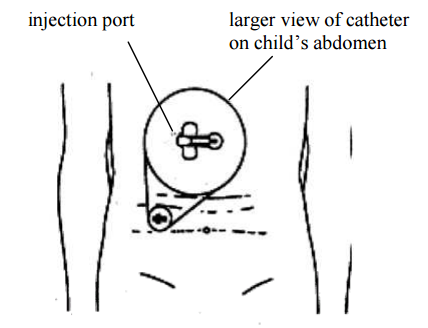
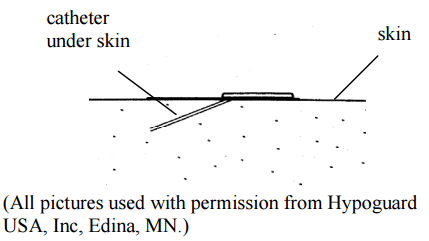
How should I prepare my child?
Use simple words to explain why the catheter is needed and what to expect. Remind your child that the tube means less pain. How much detail you give will depend on the age of your child, and the degree of anxiety about the procedure. If you need help, ask a nurse or Child Life staff member.
Explain procedures before they are done, especially what your child will see, hear, and feel. Tell your child what is expected ahead of time, such as, "Your job is to hold still while I change the dressing." This will help make care at home easier for both of you.
Preventing infection
It is very important to prevent infection, which might require removal of the catheter. The nurse will show you how to keep your supplies sterile, so no germs will enter the catheter and cause an infection.
Cleanliness is a must! Each time you do a procedure with the catheter, follow these steps:
- Prepare a clean work area by cleaning a solid surface with household cleanser (such as Lysol® or another brand) and laying a clean towel on it.
- Clean your hands well, using one of the following methods:
- Use an alcohol hand sanitizer (Purell® or another brand) according to directions.
- If hands are dirty or sanitizer is not available, wash your hands for at least 15 seconds with antibacterial soap, rubbing all surfaces briskly, including under fingernails. Use a paper towel or clean hand towel to dry your hands, and then use the towel to turn off the faucet.
- Before each time you inject any medicine, scrub the injection cap for 30 seconds with a fresh chlorhexidine wipe, using friction. Let it dry. Do not fan or blow on it.
How do I give the medicine?
- Prepare the work area.
- Clean your hands well (see above).
- Gather supplies:
- chlorhexidine wipes
- syringe of medicine, with a ½ inch needle
- sharps container, such as:
- a special container for this purpose
- 2-liter plastic bottle with lid
- coffee can with cover
- plastic detergent bottle with lid
- Check the site. If you see any signs of infection (redness, warmth, swelling, or pus) do not give the medicine. Remove the old catheter and put in a new one, if you have been taught to do so. Call your home care nurse or clinic about the signs of infection.
- Scrub the injection port with a chlorhexidine swab and let it dry.
- Insert the syringe needle into the hub, turning it gently as you go. Do not push the needle tip farther than the hub, as this could damage the catheter.
- Push the plunger to inject the medicine into the catheter.
- Pull the needle out of the catheter.
- Leave the needle on the syringe, and put the whole unit in the sharps container.
Inserting the catheter
Your child's catheter might be put in at the hospital, in the clinic, or by a home care nurse. If you have been taught how to put in the catheter, follow these steps.
- Pick a site to insert the catheter, away from skin folds or the edges of clothing. Your nurse will show you the best sites to use. Be sure to use a different spot than you did last time.
- Apply anesthetic cream: If you are going to use anesthetic cream to reduce the discomfort of the needle, apply it 1 to 4 hours before you insert the catheter. Follow the instructions that come with the cream, or see the education sheet "Anesthetic cream."
- Get another person to help you. Some children need help holding still.
- Prepare the work area.
- Clean your hands well.
- Gather supplies:
- adhesive foam pad (securing device)
- chlorhexidine wipes
- skin prep
- subcutaneous catheter (Insulfon™)
- sharps container, such as:
- a special container for this purpose
- 2-liter plastic bottle with lid
- coffee can with cover
- plastic detergent bottle with lid
- Wipe off the anesthetic cream, if used, with a clean cloth.
- Clean the site with chlorhexidine for 30 seconds and let it dry.
- Apply skin prep to protect the skin and make the adhesive stick better.
- Open the catheter package without touching anything inside and lay it flat on your work surface.
- Pick up the catheter. With your other hand, take off the cap, and. put it in the rear of the grip.
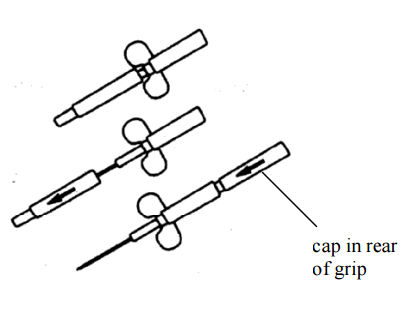
- Hold the catheter in one hand, as shown.
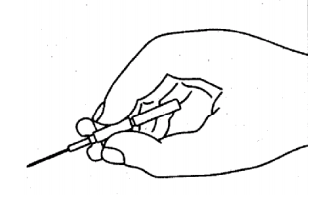
- With your other hand, pinch up the skin at the site. Insert the catheter at a 20-to 45-degree angle in one smooth, quick movement.
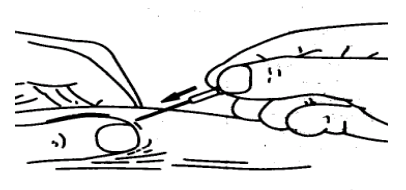
- Hold the catheter wings against the skin firmly with one hand, and pull the needle out slowly with the other. Put the needle in your sharps container.
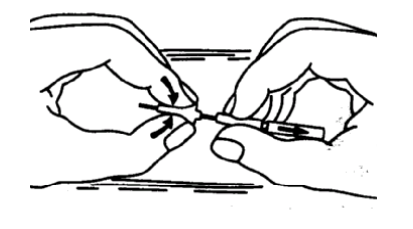
- Continue to hold the catheter in place while you apply the adhesive foam pad. Make sure the injection site is covered with the clear window first, and then press around all the edges and the wings of the catheter, to be sure it is secure.
- The foam pad works best if not disturbed for several hours. No bathing or exercise until it is well attached.
When should the catheter be replaced?
As often as directed, or sooner if:
- the foam pad is loose
- the catheter comes partway out
- leaking, bleeding, or pus at the site
- redness, swelling, or pain at the site
If any of the above occurs, carefully peel off the foam pad, starting at the catheter end and pull the catheter out. Put it in the regular trash unless blood is in it. If soiled with blood, use a sharps container.
When should I call the clinic?
- temperature higher than 101.5° F
- any signs of infection: redness, warmth, swelling, or pus at the site
- any problems inserting a catheter any problems giving the medicine
What else do I need to know?
Your child can swim or bathe once the foam pad is sticking well to the skin. Avoid very warm water or salt water.
Questions?
This is not specific to your child, but provides general information. If you have any questions, please call the clinic.
Reviewed 7/2022
This page is not specific to your child, but provides general information on the topic above. If you have any questions, please call your clinic. For more reading material about this and other health topics, please call or visit Children's Minnesota Family Resource Center library, or visit www.childrensmn.org/educationmaterials.
© 2024 Children's Minnesota
